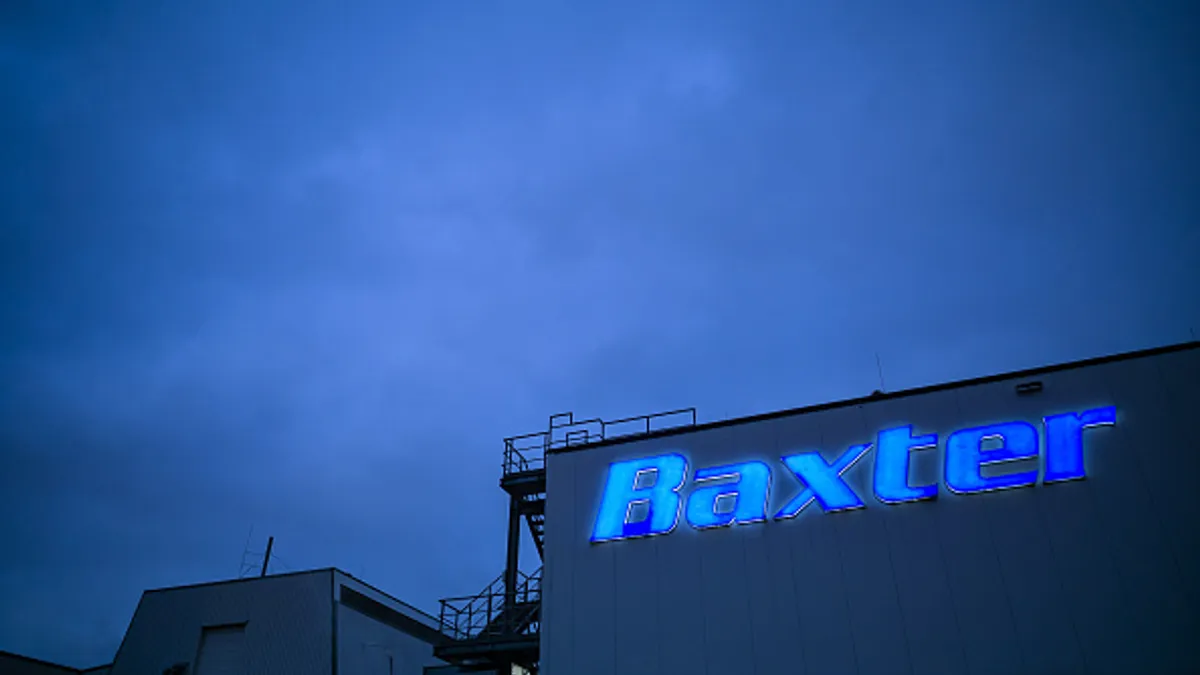Dive Brief:
- Despite beating revenue expectations for 2021, Baxter International's stock was still down at market open on Thursday. The company reported revenues of $3.5 billion for the fourth quarter, up 10% from 2020, driven by better than expected growth in its renal care business. Like other medtechs, it saw a slowdown in surgical procedures due to healthcare staffing shortages during the pandemic.
- Baxter's margins took a hit from increased costs of procuring supplies and shipping. During the most recent surge in COVID-19 cases, employees who had gotten sick or been exposed to the virus were not able to work in Baxter's plants, and the company also had to pay for expedited shipping. CFO Jay Saccaro said the company expects these problems, largely driven by the omicron variant, to resolve in the short-term.
- Executives on Thursday shared with investors Baxter's plans for integrating Hillrom, which was acquired for $10.5 billion at the end of 2021. CEO Joe Almeida provided a few details about how Baxter plans to integrate Hillrom's remote patient monitoring capabilities with its core business as it expands into connected care products. Baxter's fourth-quarter and full-year 2021 results only reflected 19 days of contribution from Hillrom.
Dive Insight:
Baxter began integrating Hillrom, after closing its acquisition in December. Baxter's decision to buy Hillrom was an effort to expand into connected care and offer digital health products across the continuum of care. The $10.5 billion acquisition was one of the largest deals of 2021, though investors questioned the strategic fit between the two companies.
In particular, Evercore ISI analysts late last year said the two companies "need to do work" on the integration of Baxter's infusion pump business with Hillrom's digital health products.
In Thursday's earnings call, Baxter's executives fielded some questions about how the two companies would work together. One short-term opportunity for the companies is to combine home dialysis with remote monitoring, which could provide insights on fluid overload, patients' vitals and workflow, Almeida said on the call. The CEO also sees an opportunity to help with workflow in medsurg units in hospitals and reduce alarm fatigue.
Both Hillrom and Baxter's core businesses have been affected by inflation and supply chain challenges, a common hurdle across the medical device industry. Saccaro said the company has been dealing with "some of the highest levels of backorders both on the Baxter side or the Hillrom side that we've ever seen," though the CFO expects these challenges to resolve in the next year.
"What's interesting is we are seeing improvement in absentee levels at our plants. We are also seeing the supply chain situation improve as we speak," Saccaro said. "So all of these things we believe are short-term in nature."
The increased costs affected Baxter's fourth-quarter margins, but it "clearly impacts" the company's first-quarter of 2022 and its guidance for the rest of the year, the CFO said. The company expects to be on a more normal trajectory by the second half of the year.
In the first quarter of 2022, Baxter expects sales growth of 24% to 25% on a reported basis, with identical growth for the company over the full year.












